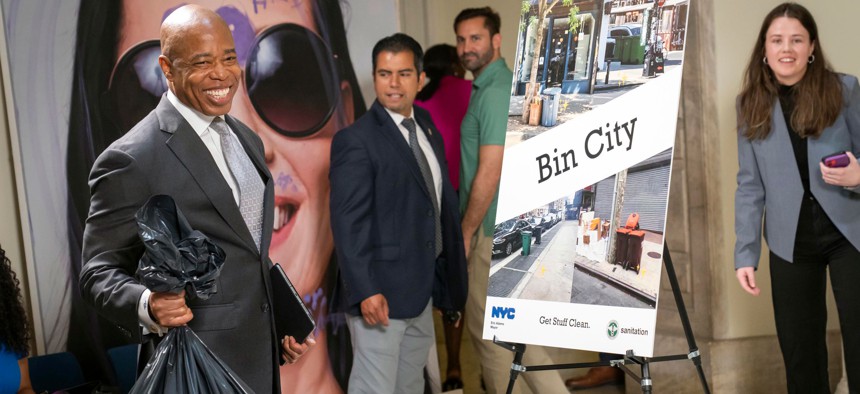Policy
NYC food establishments to be required to use trash containers
The switch from loose garbage bags left curbside is the next phase in the city’s rat mitigation efforts

Mayor Eric Adams at City hall Wednesday announced the launch of the next two phases in getting bags of trash off of city sidewalks. Ed Reed/Mayoral Photography Office
In front of the grand marble staircase in the lobby of City Hall, New York City Mayor Eric Adams threw down a tied-closed black trash bag at the base of his speaking podium.
This was the way he chose to kick off a joint announcement between him and Department of Sanitation Commissioner Jessica Tisch on Wednesday. Together, they announced two new city regulations requiring all food-related businesses and all chain stores with five or more locations in the city to start placing their trash in containers, rather than in piles of loose bags on the curb. The regulations are just the next phase in the city’s rat mitigation plans.
“I want to talk about how we’re moving our city forward in improving the quality for all of us, to get rid of those bags,” Adams said, pointing down at the garbage bag he’d brought with him. “All over the city we see them. They are a relic from the past.”
Starting Aug. 1, food businesses - restaurants, bodegas, delis, grocery stores - will no longer be allowed to place their trash out for collection in garbage bags. They’ll be required to place the garbage bags in 30 to 96 gallon trash containers. All chain businesses with more than four city locations will be subject to the same restrictions.
The businesses can keep the trash containers inside, if they have room, along their property line or within three feet of the line - as long as the trash is in a bin that can keep rats from ripping into it to have dinner.
“Less access to food means fewer rats,” Tisch said. And she may have a point.
Rat 311 complaints have decreased since the implementation of some of the city’s rat mitigation measures. As of April 1, businesses and residents have had to wait until 6 p.m. to set out their trash bins or until 8 p.m. to set out their loose trash bags the night before collection, in contrast to the previous 4 p.m. set-out time. The idea is that the later the trash goes out, the less time it spends out on the curb where rats can get into it.
Reported rat sightings are down by 15% in May and 26% so far in June. While this is just preliminary data from 311 calls, it hints that the city’s efforts are associated with decreasing rat encounters.
“The haters and doubters wondered if it would make a difference; sometimes they didn’t even wonder, they just insisted it wouldn’t,” Tisch said. “Well, the numbers don’t lie.”
The mayor made it his mission at the start of his tenure to end the rat problem in New York City. Made viral by Adams’ “rats don’t run this city, we do” slogan and appointment of a rat czar, the Rat Action Plan is a series of City Council bills the mayor signed that relate to keeping the streets cleaner as a way to reduce the rat population.
“As I say over and over again, I hate rats and rats love garbage bags,” Adams said.
Some of these earlier rat and trash regulations required later the trash set-out times, increased curbside composting, annual rat reports from the Health Department and rodent-resistant garbage bins to be used by buildings with repeat rodent violations. The plan also requires that rat mitigation zones be set up in the communities with the majority of the rat complaints. Buildings within these zones face increased violations enforcement.
There have been 45,000 summonses and warnings given out by Sanitation since April 1 over set-out violations, according to Tisch.
While early numbers may inspire hope in rat haters, not everyone is a fan of the new containerization regulations.
“If we don’t mandate containers be placed in the curb lane, we’re just replacing one sidewalk nuisance with another, more visually pleasing, one,” Open Plans Co-Executive Director Sara Lind said in an emailed statement. “Containers in the curb lane are tidier, less burdensome for pedestrians, easier for businesses to manage, and simpler for sanitation workers to collect. There are much more impactful changes possible if we look beyond free parking at the curb.”

